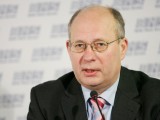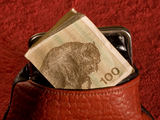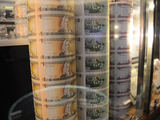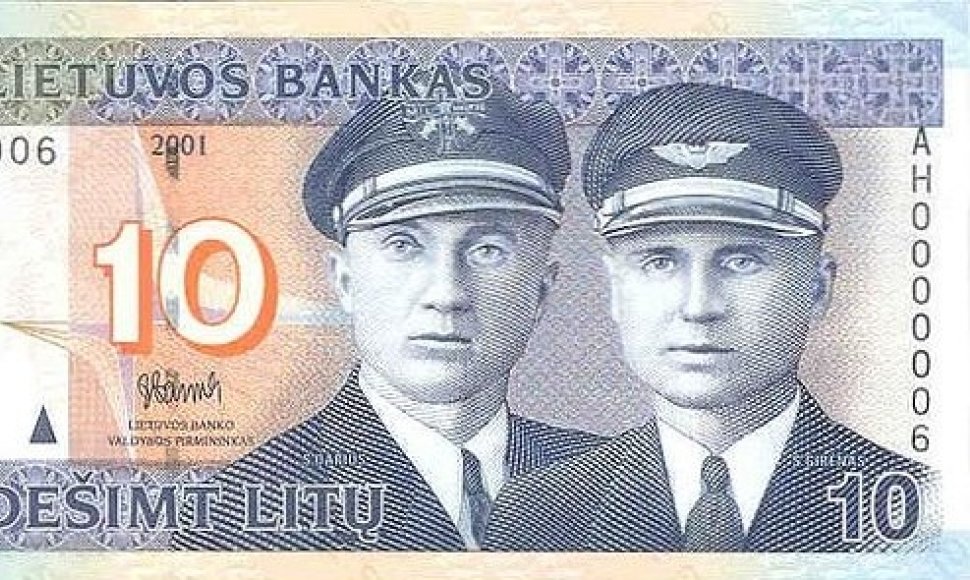After Lithuania declared its independence from the Soviet Union, it has changed currencies twice. Economists, politicians, as well as law enforcement officers still remember how the processes of rejecting the rouble and introducing the litas were accompanied by shady dealings and how criminal elements managed to exploit the period of radical change.
Underground printing of money
The issue of introducing national currency was raised as soon as the Supreme Council declared Lithuania an independent state in 1990. Inflation was raging across the Soviet Union and it was made even worse by the banknote “reform” authored by the then Prime Minister of the USSR Valentin Pavlov.
 |
| Gediminas Vagnorius, Lithuania's former prime minister |
Money was losing its value at such a pace that the Central Bank of Moscow could not print enough rouble notes. The Lithuanian leadership had to come up with a way – and do it fast – of getting a separate currency and thus hopefully curtailing inflation.
Temporary vouchers were introduced that were soon dubbed “animals” (the notes were decorated with pictures of animals) or “vagnorkės” – after the then Prime Minister Gediminas Vagnorius. Beginning in 1991, these vouchers were used as universal method of payment and had to be presented in addition to roubles. Very soon, vouchers became the principal means of conducting economic transactions.
The way that the first issue of “vagnorkės” was printed remind an episode from a spy novel. According to Vagnorius himself, even though Lithuania had already declared independence, it was not recognised de jure by the rest of the world and Soviet special services were still operating within its borders, so the new currency had to be printed in total secrecy.
“Numerators were brought separately from Sweden, dye – from Germany and Switzerland. Everything was assembled in Lithuania and the notes printed almost in the underground. Despite the challenges, several months after the tragic January events (in 1991), the vouchers were put into circulation,” the former prime minister recalls.
 |
| Vouchers, Lithuania's first post-Soviet national currency |
Meilutė Jasienė, director of the Finance Department at the Faculty of Economics of Vilnius University, was heading the Foreign Relations and Information Department at the Bank of Lithuania in 1992. She recalls that not everyone was happy with the plan of having a national currency: “Great many people from the Soviet banking establishment actively opposed the introduction of our own money. Some people simply did not understand it, some wanted to protect their own interests and remain in the rouble zone.”
Financial diversions
Having started pursuing independent monetary policies, Lithuania feared that the occupying forces might flood the country with inflated roubles.
And there already had been a precedent for that. In summer 1990, Mykolas Burokevičius, the first secretary of the Communist Party who was loyal to Moscow, founded the Association of Free Entrepreneurs and used the Bank of Naujoji Vilnia, one of the first commercial banks in the country, to finance it. The USSR State Bank granted the Bank of Naujoji Vilnia the status of an all-union bank, opened an account, and extended a credit of 280 million roubles for the year 1991.
 |
| Zigmas Vaišvila |
Zigmas Vaišvila, who was then deputy prime minister and head of the State Security Department, says that great many individuals close to Burokevičius' party became stinky rich via the Bank of Naujoji Vilnia: “Russians would pay all military officers, communist youth leaders, party figures, the entire Burokevičius gang. They'd lend as much money as they wanted. Many people made a fortune during the inflation. Including KGB officers.”
Vagnorius' memories from this period of radical change are similar: “Over the years 1991-1992, the politicized financial system of Russia could have dumped fictitious roubles on the Lithuanian market. In 1991, between the January putsch and the August putsch, a fictitious rouble emission was carried out via the Bank of Naujoji Vilnia.”
Where did roubles go?
The transition from the rouble to the temporary currency, the vouchers, was by no means plain sailing either. Legends and suspicions abound regarding the fate of rouble notes that were taken out of circulation. There were talks that Vilnius criminal bosses capitalized on the money.
Journalist Dailius Dargis, who has investigated the fate of Russian roubles, quotes prosecutor Gintaras Jasaitis of the Prosecutor General Office. “How were the rouble notes taken out of Lithuania? On what aircraft? A little information leaked out at the time, but no one did anything about it. I am certain that special services were well informed about the circumstances,” the prosecutor once commented.
There are still legends in Vilnius about how shrewd underground characters with links to the Russian nomenklatura or the new Lithuanian government would load worthless roubles onto trucks or planes and secretly take them to the Soviet Union where they'd use the money to buy tangible assets. They'd later sell them and make some capital for their further ventures.
No control over money flow
Former prime minister Vagnorius says he has heard similar talks but attaches no particular importance to them: “Late Bronislovas Lubys, who was the prime minister at the time, could tell you more about the deportation of rouble notes. But I do not give credence to these rumours. If it were indeed so, then Moscow – more than capable and willing to defend its monetary interests – would have made a scandal of it,” he says.
It was not easy to control such massive flows of cash, especially for the newly established law enforcement institutions of the young state.
“Back then, the Lithuanian government had no real control over the border or certain financial instruments. It was impossible to control rouble flows. Russia's central bank was printing money offhandedly. While switching to our own currency, it was the Bank of Lithuania that was collecting rouble notes. It kept a record and was obliged to return the notes to Russia. But it was a time when governments followed one another. Hyperinflation hit Russia later than it hit Lithuania. Against this background, opportunities during the transition period to abuse the system were more plentiful than one can imagine now,” Vaišvila recalls.
 |
| Vladas Terleckas |
Economist Vladas Terleckas, who was one of the Independence Act signatories, tells 15min about negotiations with the Russian State Bank on the terms of the handover – the roubles, taken out of circulation in a civilized way, were to be kept in the vaults of the Bank of Lithuania.
“And this was what the first management of the Bank of Lithuania did. When they resigned, in 1993 and later, the media used to run stories about shipments of roubles to Russia, about the money being lent to commercial banks. Perhaps someone did business. How could it have been otherwise, as the board of the Bank of Lithuania was made up of yesterday's policemen and similar “bankers”,” he says.
No protection against counterfeiting
The second monetary reform in Lithuania happened in 1993, when vouchers were replaced with litas. Once again, controversial decisions and suspicions of KGB involvement were plentiful. Moreover, the first issue of litas notes was of particularly bad quality.
“The government and the Bank of Lithuania management agreed to print litas notes as cheaply as possible with only basic precautions against counterfeiting. Only notes of higher denomination were to be better protected. Many factors were taken into our consideration. To print an issue of money cost 8-10 million US dollars, while the Government had only several hundred thousand in its dollar account. And with a likely hyper-inflation in sight, it was hardly to be expected that people would want to forge litas notes,” Terleckas says.
According to him, the law enforcement later revealed that one KGB agent, who was employed at the Bank of Lithuania, compromised the higher-denominated notes by instructing a printing house in the US to remove a security thread.
It was decided to not exchange vouchers for litas at a one-to-one ratio but rather make the litas more valuable, in order to ease transactions. It was, however, a last-minute decision.
“In preparation for introducing the national currency, the Litas Committee decided to set a one-to-one exchange rate. It was thought that this way we'd be able to avoid speculation and rounding-up of prices. The committee did not change its position, but the Government decided to exchange vouchers at a rate of one hundred vouchers for one litas. This presented extra technical difficulties, since they had printed as many litas notes as there were vouchers in circulation. We had more high-denomination notes than we needed. The thousand-litas note was never released. Meanwhile we were short on low-denomination notes,” Jasienė recounts.
According to regulations, surplus litas notes were to be destroyed – even though no one can confirm it actually done with any certainty now.
There were surplus litas notes afterwards, too. The initial design of the litas was not safe, there were a lot of counterfeit notes in circulation. It was decided to gradually replace the old litas notes with a new design, one that was better protected against forgeries. Notes taken out of circulation were to be destroyed. Were they? No one can bet their life on it either.
Eternally temporal
The first litas notes were printed as early as in 1991. They were easy to counterfeit, but the litas, covered with the Government's foreign currency and gold reserves, managed to stabilize Lithuania's finances and inflation abated.
 |
| Luko Balandžio nuotr./Exposition at the Bank of Lithuania |
In 1994, Lithuania introduced a currency board and fixed the litas-US dollar exchange rate at 4 to 1. In 1999, the litas was pegged to the euro. The currency board is still in place.
According to Terleckas, the voucher-litas and later litas-dollar exchange rate was probably set based on prices in Gariūnai – the biggest open-air market in the country at the time. The dollar was over-valued and it had a depressing effect on Lithuanian exports as it unilaterally favoured foreign investors.
Jasienė says that when Lithuania opted for the currency board, it was thought of as a temporary measure: “Many economists warned – it was not a complicated model to introduce, but leaving it would be quite challenging. Their warnings proved to be correct. A currency board is usually set up as a short-term measure. That's what they said in Lithuania, too. After inflation was under control, they should have given up the currency board. There was a monetary policy programme for 1996-1999 drafter by the Bank of Lithuania. It envisaged abandoning the currency board model within three years. The programme was not implemented and no one speaks of it any more.”
Attraction and repulsion of the euro
The experience of currency change, savings eaten up by hyperinflation, voucher-based privatization – all this left deep scars in the Lithuanian psyche. According to experts, it is hardly surprising that so many Lithuanians are sceptical about the Government's plans to introduce the euro. Their fears might not be entirely unfounded.
“People fear the introduction of the euro for good reason, because it is hard to pre-conceive all the effects this will have. Not to mention taking on extra commitments. Telling people that everything will be only good and there cannot be any negative effects is simply unfair. Litas is pegged to the euro, so we can't really know the true exchange rate on the market. With the euro, we would switch to a floating exchange rate. It is hard to envisage what the consequences will be. If it turns out that the litas is overvalued, we are looking at a price hike,” Jasienė warns.
She says that the authorities will benefit from exiting the currency board model and adopting the euro because they will no longer have to bear responsibility.
“I could compare the euro switch-over to putting Lithuania's economy into a hospital ward with contagious patients. This chatter that prices will not rise reminds me of Soviet propaganda that there was no inflation in the USSR,” Terleckas is sceptical.
Former prime minister Vagrnorius begs to differ: “Lithuania does not have a national currency. We lost it over twenty years ago, when the litas was pegged to the US dollar. We are suspended between heaven and earth – and that is the worst condition of all. For fourteen years, we've been tied to the euro – a bridle that made Lithuania's GDP lose several billion litas every year. After twenty years of such torture, it wouldn't be wise not to switch to a reliable monetary system that does not require keeping a currency reserve.”
What will the new litas-euro exchange rate be?
Another question that raises some concern is the possibility that the litas-euro exchange rate will be revised before the switch-over. The Bank of Lithuania says it will be the EU Council of economy and finance ministers that will set the exchange rate. The plan is to announce it six months before the euro zone entry.
“We are now moving ahead blindly and do not know what the exchange rate will be. Can you imagine the shock it might bring? The portfolio of euro loans in Lithuanian banks is worth tens of billions,” according to Vaišvila.
Gitanas Nausėda, adviser to the president of SEB bank, tells 15min that there is indeed a risk of that happening, but it is negligible: “Life is the best assurance. Lithuania is one of the few countries that have not revised their currency exchange rate since 1994. Our ability to stick to the fixed exchange rate system is proven by twenty years of experience. It would not be wise for anyone to try and alter the rate without a good reason. Any exchange rate revision would present a huge loss to the national economy and the people. Especially within months of euro adoption. The experience of other states that have adopted the euro shows that politicians try to avoid any unpleasant surprises. Six months before the adoption, they freeze the exchange rate at what it is on that day.”
To adopt the euro, Lithuania will have to exchange about 10 billion litas that is in cash circulation – or about 100 million notes.
















